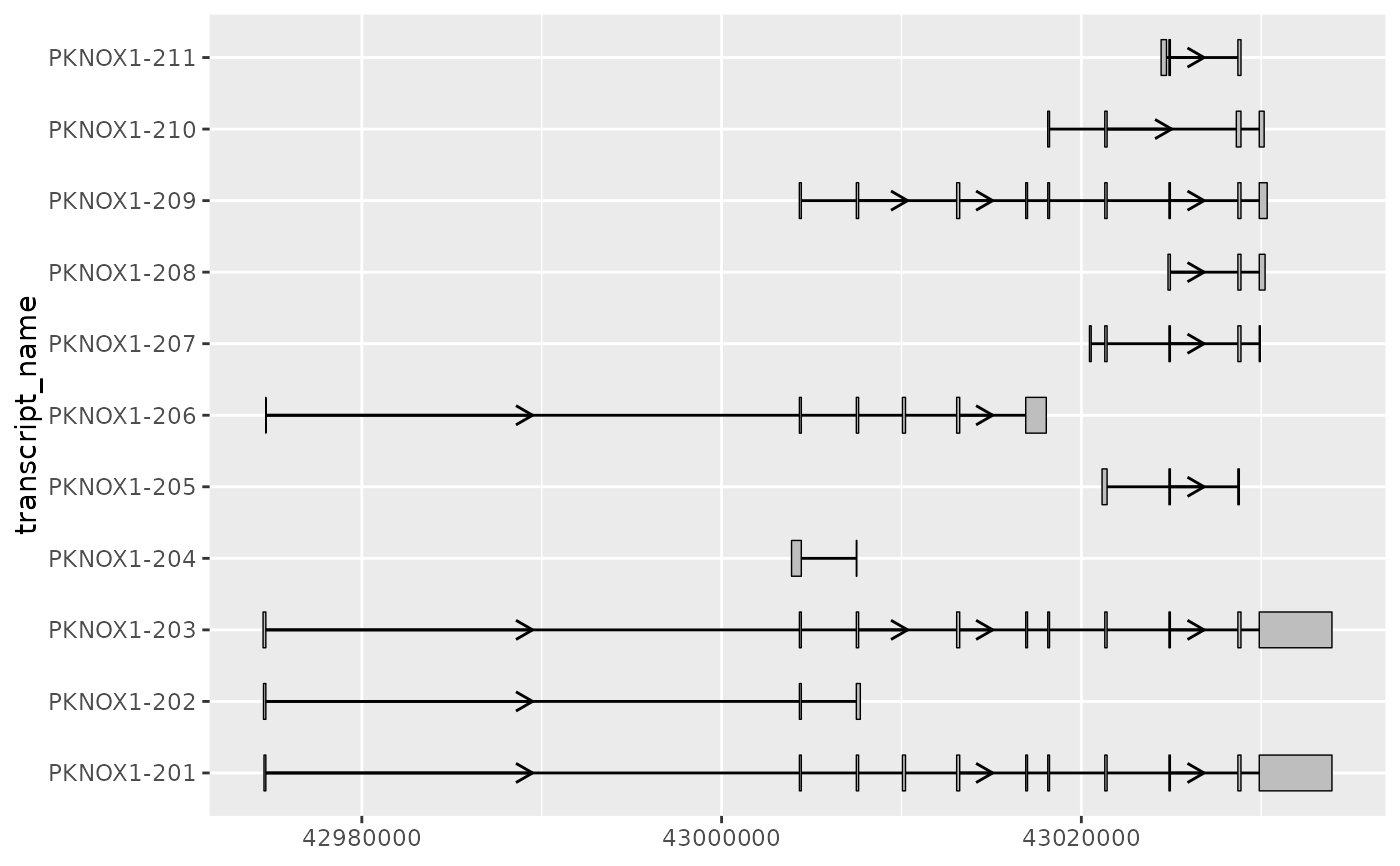geom_intron() draws horizontal lines with central arrows that are designed
to represent introns. In combination with geom_range()/geom_half_range(),
these geoms form the core components for visualizing transcript structures.
Usage
geom_intron(
mapping = NULL,
data = NULL,
stat = "identity",
position = "identity",
...,
arrow = grid::arrow(ends = "last", length = grid::unit(0.1, "inches")),
arrow.fill = NULL,
lineend = "butt",
linejoin = "round",
na.rm = FALSE,
arrow.min.intron.length = 0,
show.legend = NA,
inherit.aes = TRUE
)Arguments
- mapping
Set of aesthetic mappings created by
aes(). If specified andinherit.aes = TRUE(the default), it is combined with the default mapping at the top level of the plot. You must supplymappingif there is no plot mapping.- data
The data to be displayed in this layer. There are three options:
If
NULL, the default, the data is inherited from the plot data as specified in the call toggplot().A
data.frame, or other object, will override the plot data. All objects will be fortified to produce a data frame. Seefortify()for which variables will be created.A
functionwill be called with a single argument, the plot data. The return value must be adata.frame, and will be used as the layer data. Afunctioncan be created from aformula(e.g.~ head(.x, 10)).- stat
The statistical transformation to use on the data for this layer. When using a
geom_*()function to construct a layer, thestatargument can be used the override the default coupling between geoms and stats. Thestatargument accepts the following:A
Statggproto subclass, for exampleStatCount.A string naming the stat. To give the stat as a string, strip the function name of the
stat_prefix. For example, to usestat_count(), give the stat as"count".For more information and other ways to specify the stat, see the layer stat documentation.
- position
A position adjustment to use on the data for this layer. This can be used in various ways, including to prevent overplotting and improving the display. The
positionargument accepts the following:The result of calling a position function, such as
position_jitter(). This method allows for passing extra arguments to the position.A string naming the position adjustment. To give the position as a string, strip the function name of the
position_prefix. For example, to useposition_jitter(), give the position as"jitter".For more information and other ways to specify the position, see the layer position documentation.
- ...
Other arguments passed on to
layer()'sparamsargument. These arguments broadly fall into one of 4 categories below. Notably, further arguments to thepositionargument, or aesthetics that are required can not be passed through.... Unknown arguments that are not part of the 4 categories below are ignored.Static aesthetics that are not mapped to a scale, but are at a fixed value and apply to the layer as a whole. For example,
colour = "red"orlinewidth = 3. The geom's documentation has an Aesthetics section that lists the available options. The 'required' aesthetics cannot be passed on to theparams. Please note that while passing unmapped aesthetics as vectors is technically possible, the order and required length is not guaranteed to be parallel to the input data.When constructing a layer using a
stat_*()function, the...argument can be used to pass on parameters to thegeompart of the layer. An example of this isstat_density(geom = "area", outline.type = "both"). The geom's documentation lists which parameters it can accept.Inversely, when constructing a layer using a
geom_*()function, the...argument can be used to pass on parameters to thestatpart of the layer. An example of this isgeom_area(stat = "density", adjust = 0.5). The stat's documentation lists which parameters it can accept.The
key_glyphargument oflayer()may also be passed on through.... This can be one of the functions described as key glyphs, to change the display of the layer in the legend.
- arrow
specification for arrow heads, as created by
grid::arrow().- arrow.fill
fill colour to use for the arrow head (if closed).
NULLmeans usecolouraesthetic.- lineend
Line end style (round, butt, square).
- linejoin
Line join style (round, mitre, bevel).
- na.rm
If
FALSE, the default, missing values are removed with a warning. IfTRUE, missing values are silently removed.- arrow.min.intron.length
integer()the minimum required width of an intron for a strand arrow to be drawn. This can be useful to remove strand arrows on short introns that overlap adjacent exons.- show.legend
logical. Should this layer be included in the legends?
NA, the default, includes if any aesthetics are mapped.FALSEnever includes, andTRUEalways includes. It can also be a named logical vector to finely select the aesthetics to display.- inherit.aes
If
FALSE, overrides the default aesthetics, rather than combining with them. This is most useful for helper functions that define both data and aesthetics and shouldn't inherit behaviour from the default plot specification, e.g.borders().
Value
the return value of a geom_* function is not intended to be
directly handled by users. Therefore, geom_* functions should never be
executed in isolation, rather used in combination with a
ggplot2::ggplot() call.
Details
geom_intron() requires the following aes(); xstart, xend and y
(e.g. transcript name). If users do not have intron co-ordinates, these can
be generated from the corresponding exons using to_intron(). The strand
option (one of "+" or "-") adjusts the arrow direction to match the direction
of transcription. The arrow.min.intron.length parameter can be useful to
remove strand arrows that overlap exons, which can be a problem if plotted
introns include those that are relatively short.
Examples
library(magrittr)
library(ggplot2)
# to illustrate the package's functionality
# ggtranscript includes example transcript annotation
pknox1_annotation %>% head()
#> # A tibble: 6 × 8
#> seqnames start end strand type gene_name transcript_name
#> <fct> <int> <int> <fct> <fct> <chr> <chr>
#> 1 21 42974510 43033931 + gene PKNOX1 NA
#> 2 21 42974510 43033931 + transcript PKNOX1 PKNOX1-203
#> 3 21 42974510 42974664 + exon PKNOX1 PKNOX1-203
#> 4 21 43004326 43004432 + exon PKNOX1 PKNOX1-203
#> 5 21 43007491 43007618 + exon PKNOX1 PKNOX1-203
#> 6 21 43013068 43013238 + exon PKNOX1 PKNOX1-203
#> # ℹ 1 more variable: transcript_biotype <chr>
# extract exons
pknox1_exons <- pknox1_annotation %>% dplyr::filter(type == "exon")
pknox1_exons %>% head()
#> # A tibble: 6 × 8
#> seqnames start end strand type gene_name transcript_name
#> <fct> <int> <int> <fct> <fct> <chr> <chr>
#> 1 21 42974510 42974664 + exon PKNOX1 PKNOX1-203
#> 2 21 43004326 43004432 + exon PKNOX1 PKNOX1-203
#> 3 21 43007491 43007618 + exon PKNOX1 PKNOX1-203
#> 4 21 43013068 43013238 + exon PKNOX1 PKNOX1-203
#> 5 21 43016908 43017007 + exon PKNOX1 PKNOX1-203
#> 6 21 43018133 43018230 + exon PKNOX1 PKNOX1-203
#> # ℹ 1 more variable: transcript_biotype <chr>
# to_intron() is a helper function included in ggtranscript
# which is useful for converting exon co-ordinates to introns
pknox1_introns <- pknox1_exons %>% to_intron(group_var = "transcript_name")
pknox1_introns %>% head()
#> # A tibble: 6 × 8
#> seqnames strand type gene_name transcript_name transcript_biotype start
#> <fct> <fct> <chr> <chr> <chr> <chr> <int>
#> 1 21 + intron PKNOX1 PKNOX1-203 protein_coding 42974664
#> 2 21 + intron PKNOX1 PKNOX1-202 retained_intron 42974664
#> 3 21 + intron PKNOX1 PKNOX1-201 protein_coding 42974664
#> 4 21 + intron PKNOX1 PKNOX1-206 retained_intron 42974664
#> 5 21 + intron PKNOX1 PKNOX1-204 retained_intron 43004432
#> 6 21 + intron PKNOX1 PKNOX1-203 protein_coding 43004432
#> # ℹ 1 more variable: end <int>
base <- pknox1_introns %>%
ggplot(aes(
xstart = start,
xend = end,
y = transcript_name
))
# by default, geom_intron() assumes introns originate from the "+" strand
base + geom_intron()
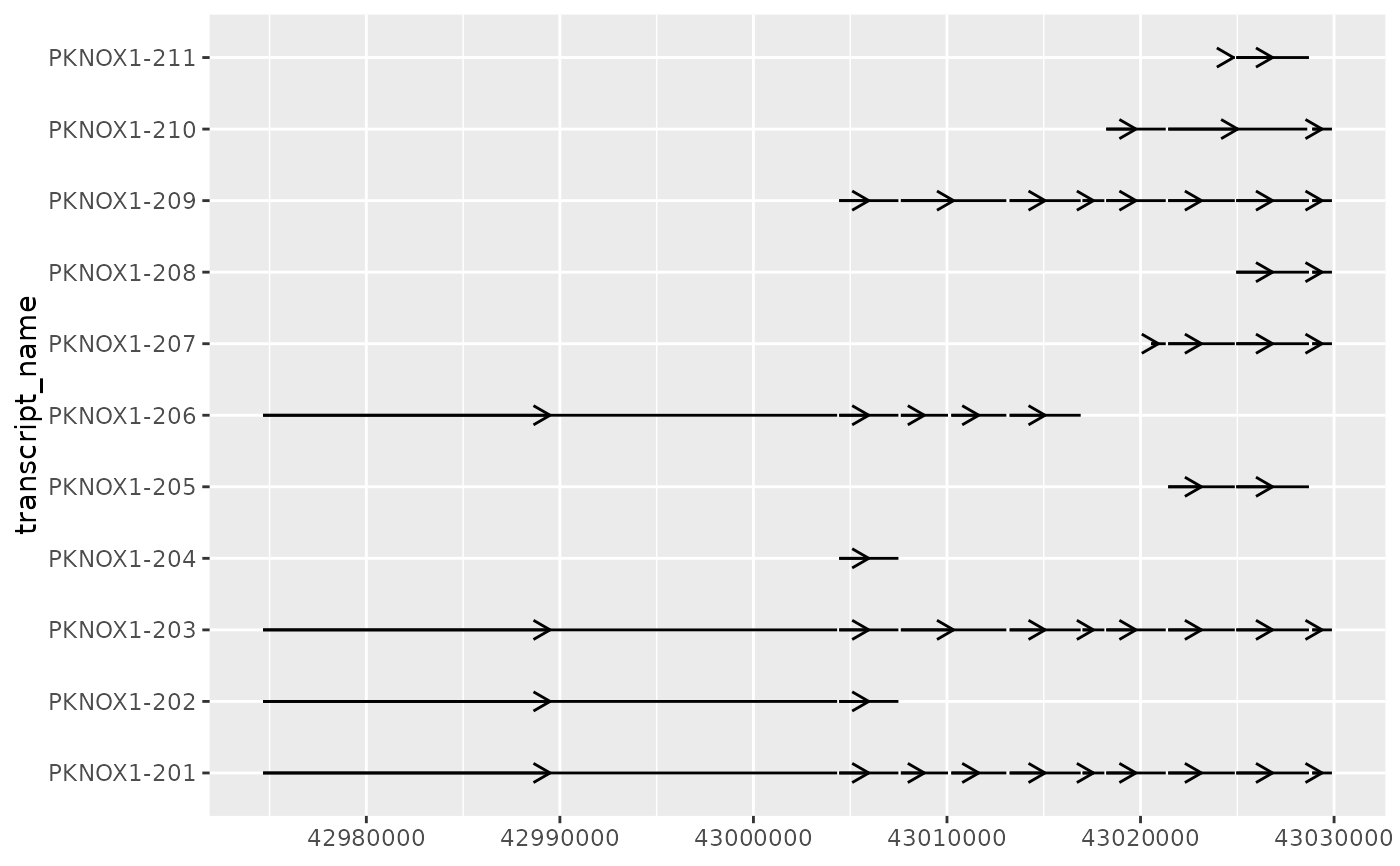 # however this can be modified using the strand option
base + geom_intron(strand = "-")
# however this can be modified using the strand option
base + geom_intron(strand = "-")
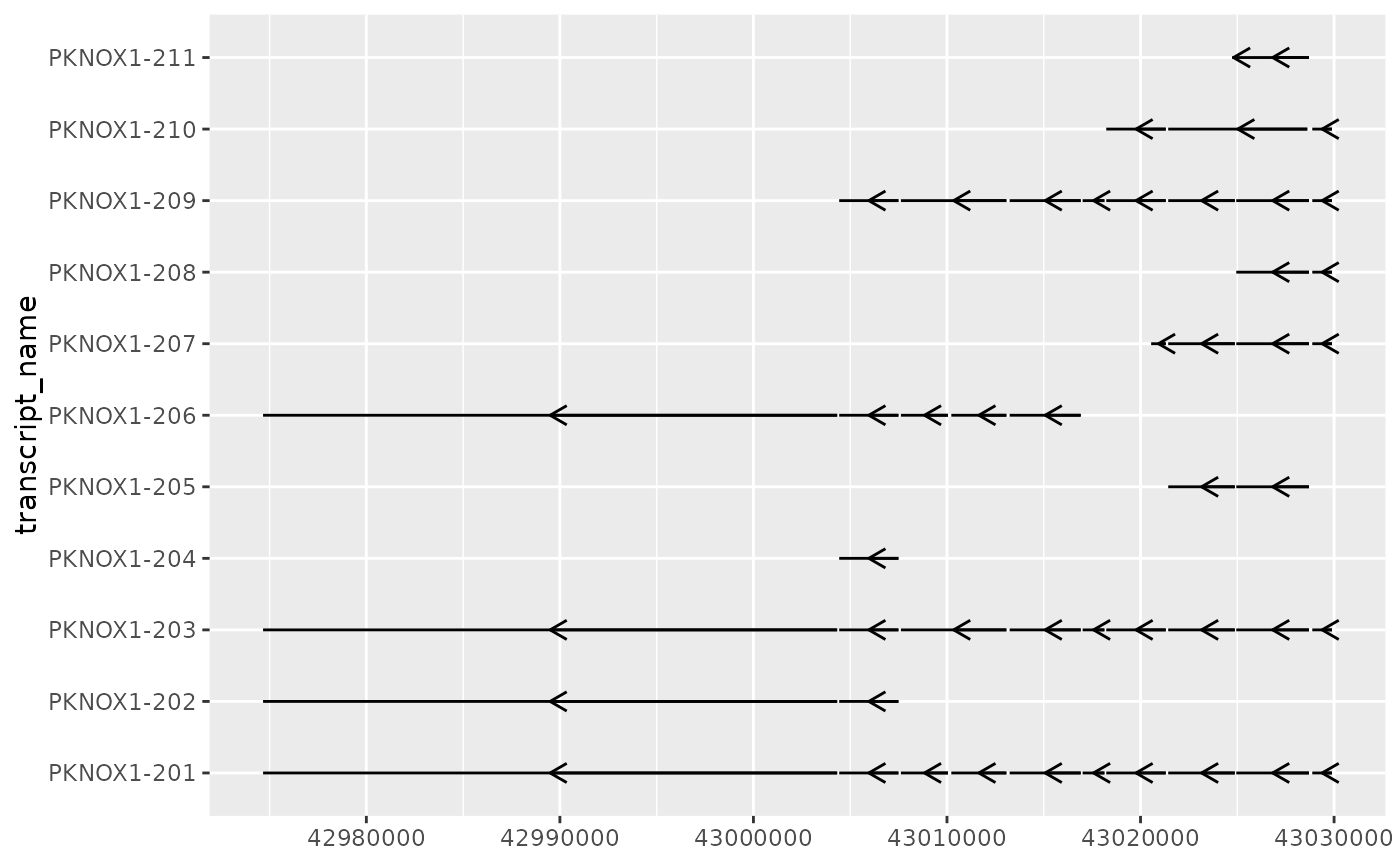 # strand can also be set as an aes()
base + geom_intron(aes(strand = strand))
# strand can also be set as an aes()
base + geom_intron(aes(strand = strand))
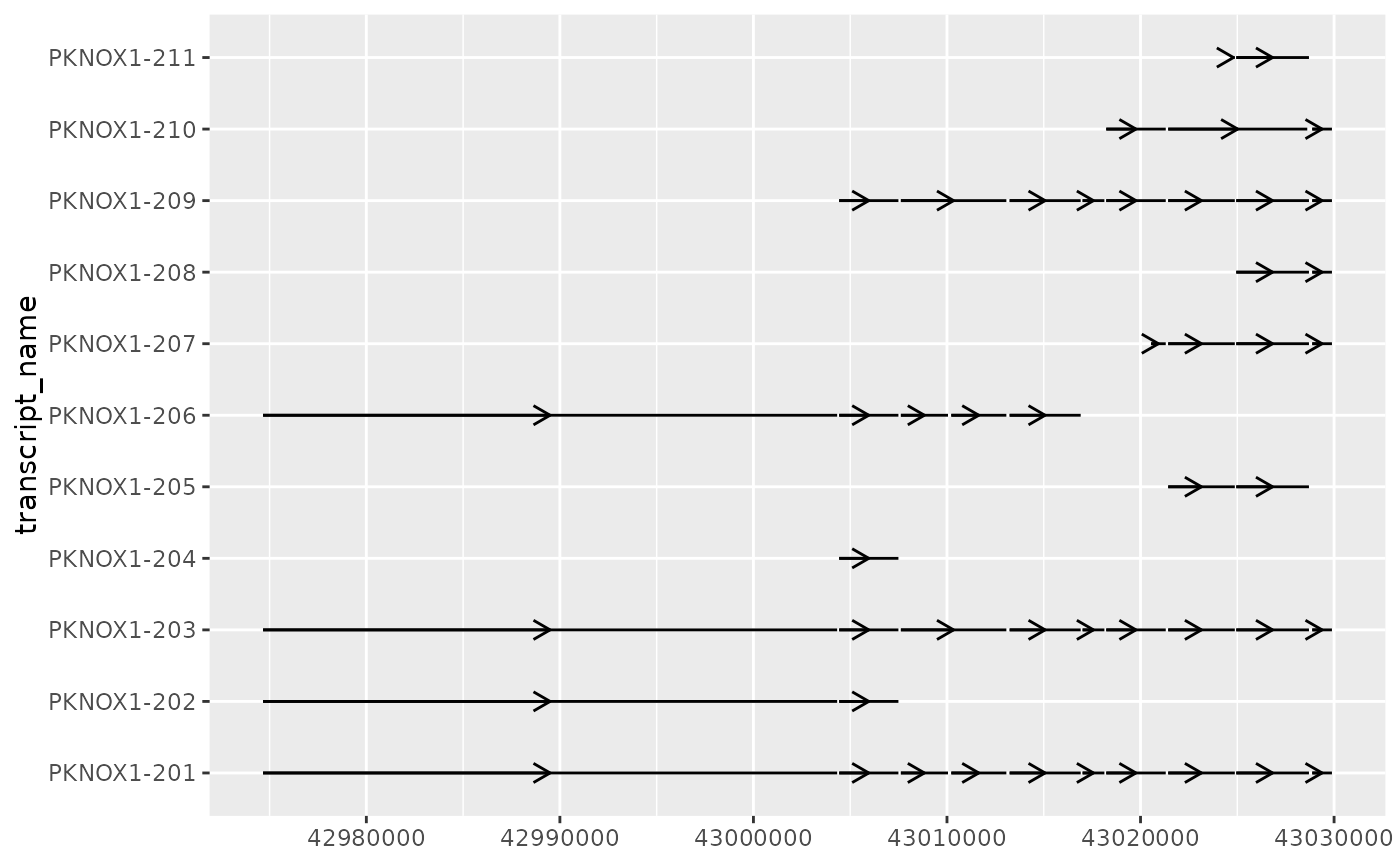 # as a ggplot2 extension, ggtranscript geoms inherit the
# the functionality from the parameters and aesthetics in ggplot2
base + geom_intron(
aes(colour = transcript_name),
linewidth = 1
)
# as a ggplot2 extension, ggtranscript geoms inherit the
# the functionality from the parameters and aesthetics in ggplot2
base + geom_intron(
aes(colour = transcript_name),
linewidth = 1
)
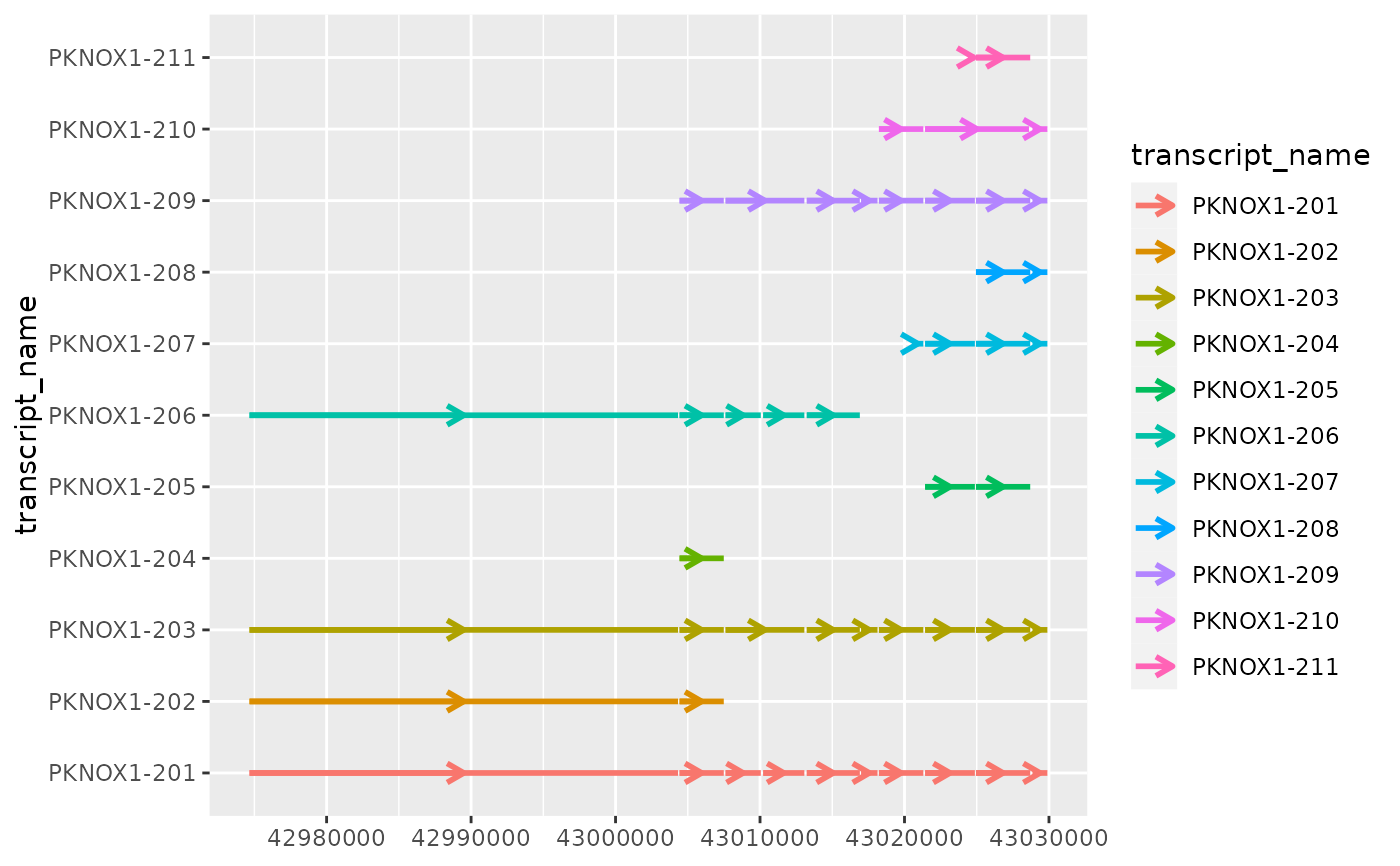 # together, geom_range() and geom_intron() are designed to visualize
# the core components of transcript annotation
pknox1_exons %>%
ggplot(aes(
xstart = start,
xend = end,
y = transcript_name
)) +
geom_range() +
geom_intron(
data = pknox1_introns
)
# together, geom_range() and geom_intron() are designed to visualize
# the core components of transcript annotation
pknox1_exons %>%
ggplot(aes(
xstart = start,
xend = end,
y = transcript_name
)) +
geom_range() +
geom_intron(
data = pknox1_introns
)
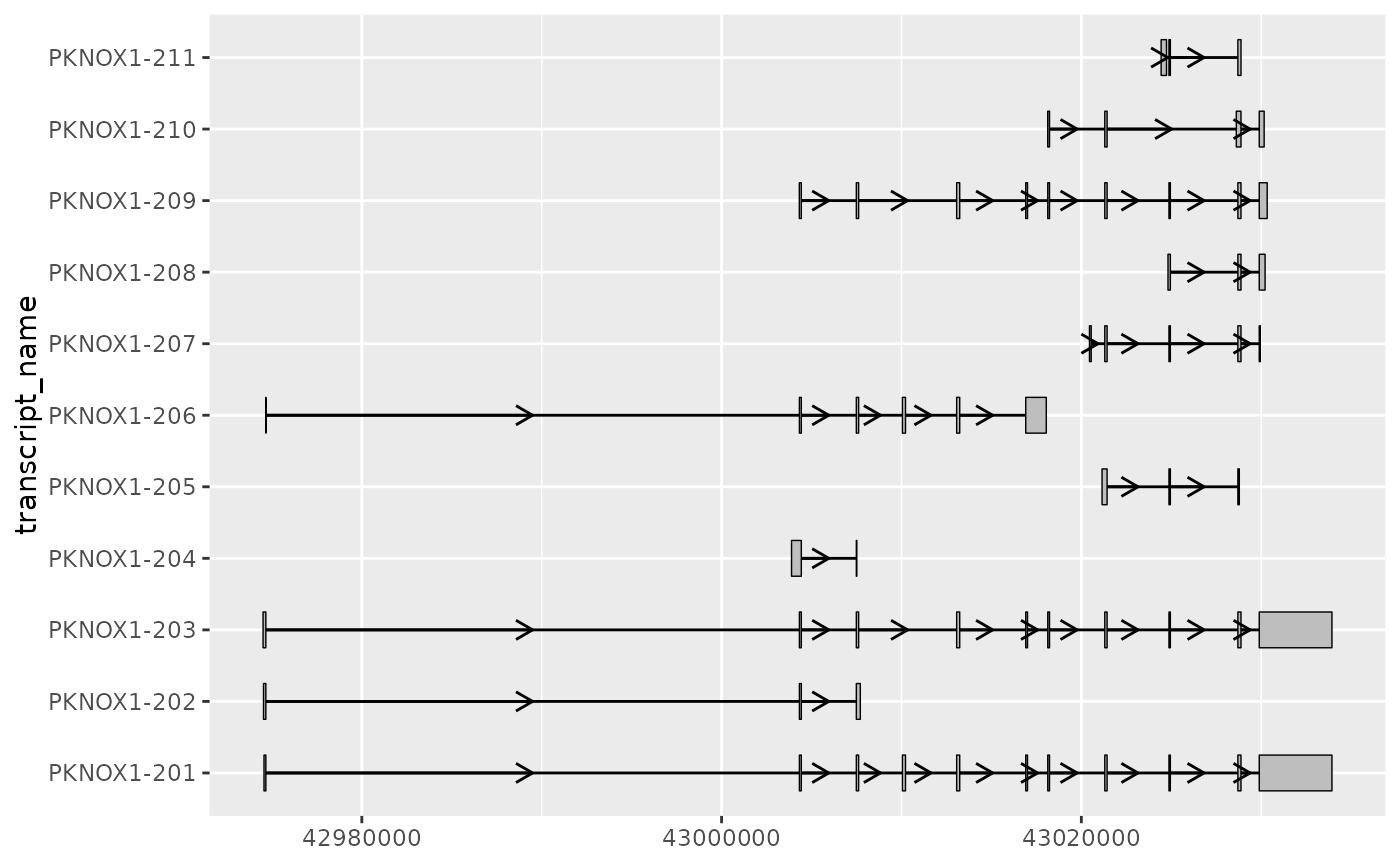 # for short introns, sometimes strand arrows will overlap exons
# to avoid this, users can set the arrow.min.intron.length parameter
pknox1_exons %>%
ggplot(aes(
xstart = start,
xend = end,
y = transcript_name
)) +
geom_range() +
geom_intron(
data = pknox1_introns,
arrow.min.intron.length = 3500
)
# for short introns, sometimes strand arrows will overlap exons
# to avoid this, users can set the arrow.min.intron.length parameter
pknox1_exons %>%
ggplot(aes(
xstart = start,
xend = end,
y = transcript_name
)) +
geom_range() +
geom_intron(
data = pknox1_introns,
arrow.min.intron.length = 3500
)
